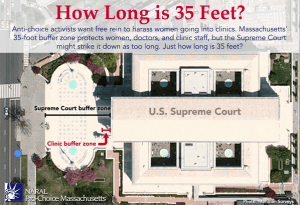|
|
Interesting Reading in the Interweb Tubes
- Prey (“Unbeknownst to me, I wasn’t preparing to survive another attack, but rather to execute one.”)
- Why I’m so happy to be Foyled again (“Imagine getting to the end of your days with a lifetime of reading behind you and there being nothing to show for all those experiences save a slab of plastic, the contents of which are only licensed to you and could be cut off on a whim at any moment.”)
Blog Headline of the Week
Best Medical Advice of the Year
Bookish Linkage
Nonbookish Linkage
I woke up thinking a very pleasant thought. There is lots left in the world to read.
Nicholson Baker, The Anthologist
Among the big items in Thursday’s news cycle was the U.S. Supreme Court striking down a Massachusetts law creating a buffer zone around abortion clinics. It didn’t take long for a number of observers to pick up on an unusual perspective on the decision. Federal law makes it illegal to “parade, stand, or move in processions or assemblages in the Supreme Court Building or grounds, or to display … a flag, banner, or device designed or adapted to bring into public notice a party, organization, or movement.” Right now, that’s a 252 by 98 foot buffer zone, compared to a 35-foot radius in the Massachusetts law
 Almost any sensible person sees this as ironic. But who says the law has to be sensible? It actually can distinguish the two. Almost any sensible person sees this as ironic. But who says the law has to be sensible? It actually can distinguish the two.
The Massachusetts statute said no one could “enter or remain” on a “public way or sidewalk” within 35 feet of any portion of an entrance, exit or driveway of an abortion clinic. (It excluded people entering and leaving the clinic, employees, and anyone using the sidewalk or street solely to go someplace other than the clinic.) Among the things that bothered the Supreme Court was that the statute restricted activity on public sidewalks, long recognized as ideal areas for First Amendment activities. Moreover, it didn’t matter what a person in the buffer zone was doing. If, for whatever reason, someone wanted to eat lunch or read a book within the 35 feet, they were breaking the law.
The federal law, 40 U.S.C. § 6135, seems to raise similar questions. In fact, in 1983 the Supreme Court held the statute unconstitutional — when it came to public sidewalks. As a result, subsequent court decisions allowed the statute to apply to the plaza and steps of the Supreme Court building. They reasoned that, unlike public sidewalks, the plaza hasn’t historically been a place for public expression. Thus, the public sidewalk issue key to the Massachusetts decision disappears.
The federal law also can be distinguished because, for example, it doesn’t preclude simply entering and strolling around in the plaza. But that doesn’t necessarily mean it’s constitutional. In fact, last June a federal judge said that even as applied to the plaza the statute violated the Constitution because absolutely bans the activities it covers. In other words, it doesn’t matter why someone might be gathering in the plaza or why a group of people may be parading in it. Just two days later, the Supreme Court adopted a regulation barring “demonstrations” on its grounds that are “reasonably likely to draw a crowd or onlookers.”
That regulation doesn’t change the law itself. The decision invalidating the law is now pending in a federal appeals court. It will be interesting to see if the Supreme Court ultimately ends up hearing the case and, if so, whether it will sense any irony in upholding one law and striking the other.
This clause [precluding assembling or parading on Supreme Court grounds] could apply to, and provide criminal penalties for … even, for example, the familiar line of preschool students from federal agency daycare centers, holding hands with chaperones, parading on the plaza on their first field trip to the Supreme Court.
U.S. District Judge Beryl A. Howell,
Hodge v. Talkin (June 11, 2013)
It’s surprising sometimes what the federal government looks at. As the name suggests, one of its latest reports — the American Time Use Survey — looks at the activities that make up our days. Among other things, it shows I’m once again in the minority, this time in “leisure time.”
According to the study, Americans age 15 and older spend an average of 2.57 hours a day on weekdays watching television and 3.24 hours on weekends. By my math, that’s just more than 19 hours a week. And people in my age group spend even more time watching TV, about 22 ½ hours. Unfortunately, I can’t find a definition of what constitutes watching television so it isn’t clear if something like streaming television programs is included or falls within using computers for leisure. Regardless, television doesn’t have much competition. The second ranked activity is “socializing and communicating,” which we spend about half an hour doing each weekday and double that during the weekend.
One of the more distressing items is that those 15 to 19 spend more than 5 hours watching TV on weekends but only 8 ½ minutes reading. And with the exception of slight drop for those 25 to 34, at least the amount of time spent reading steadily increases. Still, the most any age group averages reading on weekends is two hours and just under an hour on a weekday — but that’s people age 75 and older. People in my age group spend less than half an hour reading any day. In contrast, I probably spend as much time reading as others my age watch television and about as much time watching TV as they spend reading. But, as renowned philosopher Sly Stone put it, “different strokes for different folks.”
By the way, although the numbers are skewed because not everybody works, Americans spend an average of about 4 ½ hours working each day during the week, compared to more than 5 hours in leisure activities. The “activity’ we spend the most time on is sleeping, about 8 ½ hours a day.
I still find each day too short for all the thoughts I want to think, all the walks I want to take, all the books I want to read, and all the friends I want to see.
John Burroughs, The Writings of John Burroughs, Vol. 17
Interesting Reading in the Interweb Tubes
- Was This Student Dangerous? (“…despite clear and repeated instructions, the undergrad was writing things that had nothing to do with class assignments — things that made the other students afraid.”)
Blog Headline of the Week
Arrests of the Week
- A San Diego “tagger” was arrested on felony charges for tagging the courtroom in which he was awaiting his hearing on misdemeanor tagging charges
- A 20-year-old woman was arrested for soliciting sex in a Massachusetts public library
Most Depressing Survey of the Week
Bookish Linkage
Nonbookish Linkage
The man in the suit just bought a new car
With the profit he’s made off your dreams
Traffic, Title Track, The Low Spark of High Heeled Boys
I’ve posted before that there are times government elevates rules over simple common sense. While that post dealt with kids and “guns,” it now appears books can get cause government brain farts too.
 A 9-year-old Kansas boy and his family had to move their “Little Free Library” after the town of Leawood said it violated city code because it was a “detached structure.” For those not familiar with the concept, ” a Little Free Library is a box full of books where anyone may stop by and pick up a book (or two) and bring back another book to share.” A 9-year-old Kansas boy and his family had to move their “Little Free Library” after the town of Leawood said it violated city code because it was a “detached structure.” For those not familiar with the concept, ” a Little Free Library is a box full of books where anyone may stop by and pick up a book (or two) and bring back another book to share.”
Spencer Collins’ free library is shown at the left in a photo from the Spencer’s Little Free Library Facebook page. A letter from Leawood’s code enforcement officer said, “Your take a book leave a book structure must be attached to the house.” The City Administrator, meanwhile, suggested seeing if the county library would let Spencer’s Little Free Library be placed there. That makes sense. Let’s go put what is essentially a neighborhood box of books outside a building full of books.
Facing a daily $25 fine if they didn’t comply with the Leawood ordinance, the Collins put the Little Free Library in the garage. And while I’m sorry to let legal logic intrude, even if the garage it isn’t an attached structure, is it?
A Kansas City television station reported the town had received two complaints about the library and a city official told it, “We need to treat everybody the same.” True, but is what’s happening here really the intent of the ordinance. Evidently Spencer’s problem is that rather than just putting a cardboard box of books outside the house, he made an effort to present an attractive “structure.” That’ll teach him what happens if you try to provide something to your community.
He had learned the worst lesson that life can teach — that it makes no sense.
Philip Roth, American Pastoral
|
Disclaimer 
Additionally, some links on this blog go to Amazon.com. As an Amazon Associate I earn from qualifying purchases. There is no additional cost to you. Contact me You can e-mail me at prairieprogressive at gmaildotcom.
|
 Almost any sensible person sees this as ironic. But who says the law has to be sensible? It actually can distinguish the two.
Almost any sensible person sees this as ironic. But who says the law has to be sensible? It actually can distinguish the two. 







